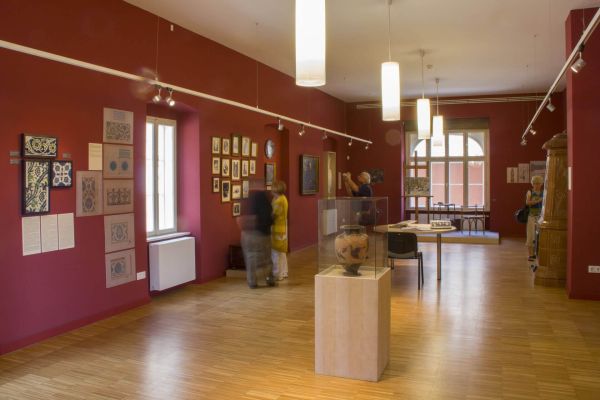In the beginnings...
The history of the factory is attached to the main stages of the history of Hungary. Its founding dates back to the Bach period, it lived its heyday during the period of the Austro-Hungarian Monarchy; that was the time of dualism. World War I and the peacemaking processes that followed broke the fast development. The era between the 2 world wars was the time of a new beginning and of modernisation. Nationalisation brought the next turning point first by breaking with and later by returning to the older traditions with artistic and technical experiments. The young industrial artists established a new and modern form language with the products of the factory while they also sensed a strong request for the keeping of the traditional techniques and forms.
Zsolnay: family and factory
The history of the factory is the exciting and colourful story of the Zsolnay family too. The figure of Vilmos Zsolnay; the genious potter lives vividly in public consciousness. The exhibition commemorates those without the work of whom this rich heritage could not have come to life. The son of Vilmos; Miklós Zsolnay was a merchant and a businessman; he made sure that the family assets stay in the hands of the family members and that the factory kept its leading position on the market. The designer works of Júlia Zsolnay are well known but she is less known for her paintings. Her older sister Teréz had an essential role in the collection and keeping of the heritage. Júlia’s husband; Tádé Sikorski wrote his name in the great book of the factory not solely as a designer, but as an architect also. Teréz’s husband; Jakab Mattyasovszky supported his father-in-law’s inventions as a geologist. Those family members whose activities were less known also had essential roles in the development of the business. The exhibition follows through the efforts of the grandchildren they had in order to keep the factory running. Without their technological inventions we could probably hardly talk about an operative factory today.
From the ornamental pieces to the porcelain insulations
The factory used to be the largest ceramics manufacture of the Austro-Hungarian Monarchy until the turn of the last century where household and ornamental pieces, building ceramics, fireplace tiles, porcelain insulations and stoneware pipes were produced. There was another factory in operation in Öv Street in Budapest starting from 1902. It was named the Budapest Porcelain and Faience Co. that primarily produced paving tiles and insulations and that kept its independence in the hands of the family until its nationalisation in 1948.
Innovators and inventions
The inventions of Vilmos Zsolnay had a great role in the success of the factory. From among these the porcelain faience and the eosin technique brought world fame to the Zsolnays whereas the pyrogranite inspired a whole architectural trend that is the Hungarian seccession or art nouveau on the turn of the last century. We shall not forget the hundreds of workers either from among whom many added to the artistic and business successes of the factory through generations or who kept the great professional quality even following the nationalisation that has always been the key to the success. One of these people was István Kovács who did not only keep the technique of eosin and revived it at the end of the 1950s. This was the artistic tradition that inspired the modern form language and the new workers and industrial artists: Antal Gazder, János Török, György Fürtös and Judit Nádor from the 1960s who are known as the classical figures of Hungarian design today.
Ticket types
-
Full price
2200 Ft
-
Student
1700 Ft
-
Pensioner
1700 Ft
-
Pedagogue
1700 Ft
-
Group
-15%
Over 10 people
Zsolnay Family and Factory History Exhibition
Zsolnay history – the palpable history
The Zsolnay family and factory history exhibition gives an insight to the visitor of the most precious moments of the life of the industrial dynasty starting with the simplest industrial ceramic items to the most decorated ornamental pieces and the life-ch
3D Tour
LocationZsolnay Negyed |

Description
Sponsors






































